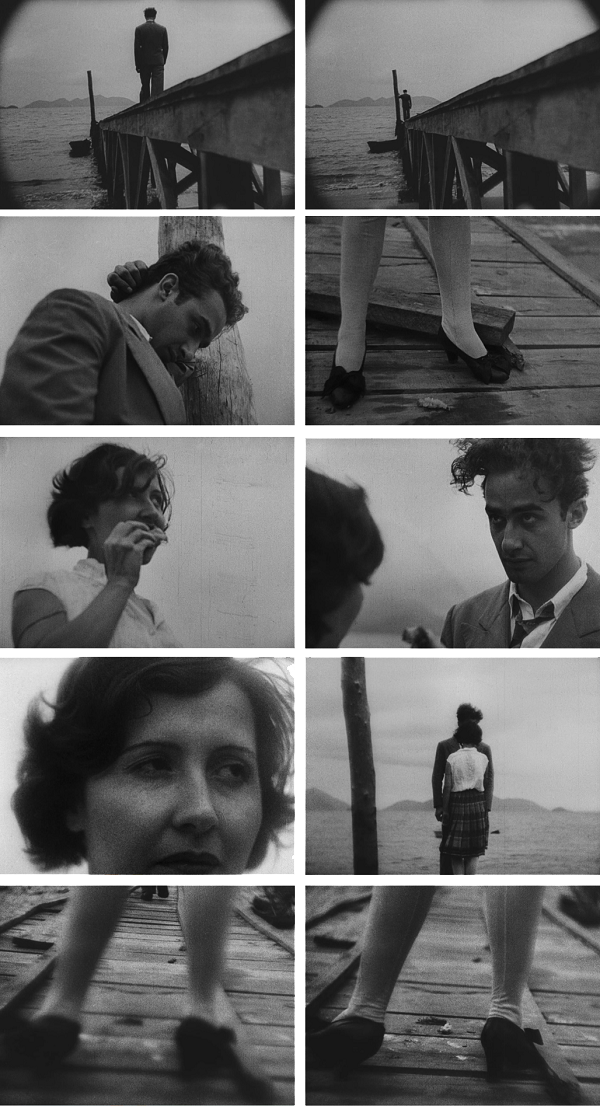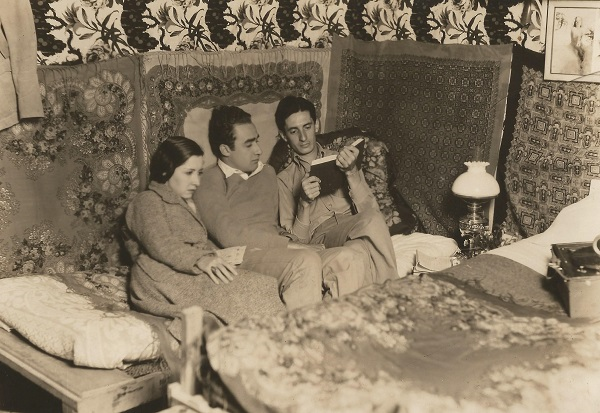Essay
Mário Peixoto and Carmen Santos:
The Relationship Between the Extraordinary Director and the Dazzling Star
By Lívia Cabrera

Her frustrated attempts to make cinema, still very young, were followed by journalists specialized in cinema, such as Adhemar Gonzaga, who at the same time worked in the creation of the magazine Cinearte, in 1926. Gonzaga and his partners Pedro Lima, Álvaro Rocha, and Paulo Vanderley followed the cinematographic productions that were made in different parts of Brazil. It was through Adhemar, for instance, that Carmen got closer to Phebo Sul America Film, of Cataguazes, where Humberto Mauro and Pedro Comello made movies. The actress joined a Phebo production, being the protagonist and co-producer, although the latter was omitted to avoid conflicts with her partner and financer, Antonio Seabra (GOMES, 1974).
It is also through the Cinearte group that Mário Peixoto gets to raise his cinematographic project. Encouraged by them, Peixoto took over as director, who borrowed Phebo’s equipment, Adhemar’s contacts, and the laboratory installed in Carmen Santos’ house (PESSOA, 2002). According to Mario Peixoto and Ana Pessoa’s statement, in 1987, the photographer Edgar Brazil, already close to Carmen Santos, worked on the film at her house, which already had some equipment due to her production initiatives. She was interested in meeting the young director and his work. Through Edgar, Mário went to Carmen’s house, as she had sent a message proposing an exchange: if he wrote her a script, she would not charge the laboratory use. According to Mário Peixoto, when he met her, he decided to test her vanity saying that he would write her a script, on the condition of her making a small appearance in Limite, but he would not credit her (PESSOA, 2002). She accepted the role of the pier’s prostitute.
The approximately three-minute-long scene was not largely spread by media as Carmen’s projects used to be and, in fact, her name is not featured in the credits. She had been looking to develop a project that allowed her to play a strong and determined woman, and she constantly used to express this desire in interviews: “because of my gypsy and romantic temperament, because of what I have suffered, of my way of understanding life, only the strong roles for the strong emotions satisfy me” [1]. Until then, the roles Carmen’s played with those characteristics were exactly the ones from the unfinished projects.
According to Ana Pessoa (2002), Carmen was thrilled with Mário Peixoto, his meticulousness in direction, and the new way of making cine in Brazil in that period He could have written her a character best suited to her wishes and the partnership would bring back the possibility of her controlling and interfering on the project as a producer, even though this technical role was not recognized, especially when it came to Carmen (CABRERA, 2020). Frequently, when Carmen was ahead of initiatives, she was treated more as a financer or “enthusiast” of Brazilian cinema, mainly by media, and it was not uncommon the internal conflicts during productions, certainly because Carmen felt disrespected. Journalists of the period and later historiography did not understand the producer as a cinema worker. The star image, in which she relied hardly upon and made it possible to get her space in the field, weighed more. But in her productions she sought to offer the best technical conditions, researching and acquiring equipment, hiring and establishing partnerships with professionals from many areas, following personally all the stages of her movies (CABRERA, 2020), as it will be reported on the project Onde a terra acaba.
The famous Limite session on Chaplin Club is from May of 1931, but in January of that same year, Cinearte will bring the news of the star’s partnership that will get the lead role from the promising director’s new movie [2]. The new partnership between Carmen Santos and Mário Peixoto is acclaimed by the press. She believed his work and he relied on her capital and her actress and producer career. Together they trusted they would make a masterpiece. Details about the movie started to come out in the press in June when the preparation was advanced. Onde a terra acaba is widely followed by several vehicles of Rio press that publish letters, reports, photographs, and even organized visits to the inhospitable film set, the island of Marambaia. They bring attention to the boldness of the project that faced many difficulties with weather and lack of conditions in the region but still got to set up an incredible structure in the island, building houses for hosting and recording, even counting with some ingenuity to improve lighting inside the location and water supply, besides a photography laboratory. Despite the difficulty, Carmen, the only woman in production, was present during the entire preparation.
For this is precisely the dramatic situation of the Marambaia Island, where for almost a month the most daring fighters of Brazilian cinema are living with the determined energy of Carmen Santos and the iron will of Mário Peixoto, plus the heroic obstinacy and persistence of Raul Schnoor, D. G. Pereira and Edgar Brazil, supported by over twenty workers who actively work for their duties. [3]


Years later, Pedro Lima promoted a reunion between Peixoto and Carmen. Mário himself addressed the topic in a text published in 1937 [7], in which he made a mea culpa regarding the project, confirming he had been too intransigent and, sometimes, inaccessible. But he also states that Carmen was “untamable”. He describes the meetings in which they talked about the possibility of resuming Onde a terra acaba and in which Carmen confessed her admiration for him and her frustration with the project’s disruption. During this reunion, they also talked about the movie Inconfidência Mineira in which Carmen had been working. Research carried out also showed some traces of projects they intended to realize together. Mário made an argument called Tiradentes for Carmen’s project [8] and, years later, she even paid him for the scripting services of the Jorge Amado’s ABC de Castro Alves [9], but none came out of the picture.
Press waited for the project from the partnership between Mário and Carmen with enthusiasm and believed in the potential it had to be the greatest Brazilian movie of all times. Years later, Pedro Lima still defended it as, even unfinished, it would have been a representant of national’s cinema progress [10]. Frustration with the work weighed on the career of the two artists, which certainly changed them. The extraordinary director never directed a film again, and the glowing star continued trying to raise several projects, idealizing achievements that would leverage the Brazilian film industry, but she did not achieve this consecration in her lifetime. Time and the review of concepts and history itself allow us to begin to see better the significance of this partnership to the history of Brazilian cinema, seeking to investigate these failures from a different perspective, opening a rich path for future analysis.
CABRERA, Lívia Maria Gonçalves. “O maior drama nacionalista do Brasil”: produção, recepção e circulação de Inconfidência Mineira (Carmen Santos, 1936-1948). Dissertação (Mestrado em Cinema e Audiovisual) – Universidade Federal Fluminense, Instituto de Arte e Comunicação Social, Niterói, 2020.
GOMES, Paulo E. Salles. Humberto Mauro, Cataguases, Cinearte. São Paulo: Editora Perspectiva, 1974.
ONDE a terra acaba. Direção: Sérgio Machado. Produção: Vídeo Filmes, Brasil, 2002 (85min).
PESSOA, Ana. Carmen Santos: o cinema dos anos 20. Rio de Janeiro: Aeroplano, 2002.
[ 1 ] NAIDE, Z. Ouvindo a estrela de Cidade Mulher. O Jornal, 29 jun. 1936.
[ 2 ] Cinema no Brasil. Cinearte, nº 256, 21 jan. 1931.
[ 3 ] Onde a terra acaba. Correio da manhã, 07 jul. 1931, p. 8.
[ 4 ] Um grande empreendimento do cinema brasileiro. O Jornal, 24 jun. 1931, p 13.
[ 5 ] Ibidem.
[ 6 ] It is possible to check the document from the registry where Carmen sues Mário at the Mário Peixoto Archive.
[ 7 ] PEIXOTO, Mário. Cinema caluniado. O Jornal, 06 mai. 1937, p. 3; 5.
[ 8 ] This information was found in the Mário Peixoto Archive and was narrated by Mário himself to Saulo Pereira de Mello.
[ 9 ] The receipt is at the MIS-RJ and there is a copy at the Mário Peixoto Archive.
[ 10 ] LIMA, Pedro. Crônicas de Pedro Lima. O Cruzeiro, 04 abr. 1936, p. 33.
